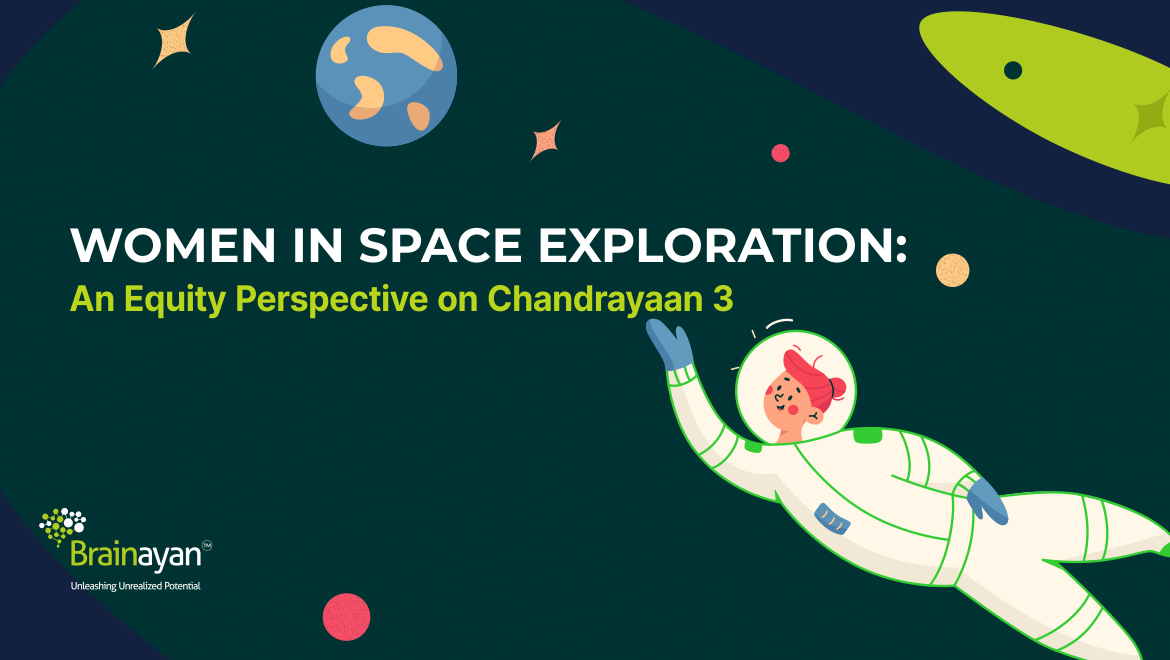Women in Space Exploration: An Equity Perspective on Chandrayaan 3

With the resounding success of Chandrayaan-3’s lunar landing, a wave of excitement has swept in, bringing women’s empowerment into the spotlight. As if that weren’t enough, the cherry on top was Prime Minister Modi’s announcement of the landing site’s name on the moon – “Shiv Shakti.” This name, rooted in the vibrant energy of Hindu mythology, pays homage to the dedicated women scientists who poured their efforts into making this mission a reality. It’s not just a landing; it’s a tribute to the indomitable spirit of women in science.
We are nothing less than proud about the success of the entire mission and cannot help cheer for and look up to wonderful women like Ritu Karidhal Srivastava, Nandini Harinath, Kalpana Kalahasti, Muthayya Vanitha, Reema Ghosh, Nidhi Porwal, Anuradha T.K., Minal Rohit, Moumita Dutta, Tessy Thomas, and other such women who have contributed towards creating history!
On the other hand, despite the evident triumphs of women’s success stories, their journey still lacks the vital support at the organizational level. The study conducted by CSIR and NIScPR found there are less women at a chief scientist level, yet again highlighting the historical trend of male-dominated leadership. In this mission as well, despite the direct involvement of many women scientists and engineers and handling various important responsibilities, it was still led by men. In fact, within the core team of the mission, there was a single woman as compared to 5 men. The recent nationwide survey within India serves as an eye-opener, portraying that a mere 13% of scientists and science faculty in Indian higher education and research institutions are women. Moreover, according to World Bank Data, despite women making up 43% of the total STEM graduates all over the world, there are just 14% of women scientists, engineers, and technologists at research institutions and universities.
Practically speaking, women have always been discouraged on financial, marital status and other such grounds. Especially in the STEM fields, women navigate through a maze of challenges, including the absence of relatable female role models, pervasive gender stereotypes, and a lack of family-friendly work flexibility (Beede et al, 2011). News articles, published in support of women in the mission, have captured gruelling work hours as a challenged they experienced. In another reported scenario, a female lead initially showed reluctance in assuming a major project responsibility. However, the project director skillfully addressed this issue by assuring her of her excellent problem-solving abilities and her capacity to manage teams. This is indeed a sign of true leadership development. Research conducted by Kur and Bunning in 2002, did propose that for leadership development it is important that individuals understand themselves and how to best manage their personal resources.
When we cast our gaze towards equity, we find a powerful solution to dismantle the gender disparities that persist. This approach not only addresses the existing gaps in leadership roles but also lays down the foundation for a balanced representation of genders across all organisational levels (WHO, 2019). Looking at Chandrayaan-3 through this lens sparks an intriguing question: How many of the men involved in the mission were already renowned or well-recognized prior to its launch? It was only after the success did the team rose to fame. Therefore, this emphasizes the notion that recognition and success should be viewed regardless of gender.
With this, here are some research-based (Coe, 2019; García-Holgado, 2020) best practices for equity in leadership:
- Facilitating access to role models from all the genders across the organisation.
- Developing organisational climate and culture that is conducive to making everyone feel safe, supported, and respected.
- Moving beyond dialogues. Leaders, influencers, and policy makers should listen to the under-represented without commenting and accepting their reality as legitimate.
- Making their contributions visible by normalizing the success of the under-represented employees by being intentional.
- Leaders being mindful about sending clear messages that the workplace values under-represented employees at the workplace.
- Creating an evidence-based and milestone-driven changes within the organization. It is critically important that members of the dominant group take an active, visible, and positive role in developing these types of key performance indicators and metrics, especially as leaders and advocates.
- Motivating employees to take up leadership roles by trusting their demonstrated abilities and not their gender or representation.
References:
Beede, David N. and Julian, Tiffany A. and Langdon, David and McKittrick, George and Khan, Beethika and Doms, Mark E., Women in STEM: A Gender Gap to Innovation (August 1, 2011). Economics and Statistics Administration Issue Brief No. 04-11, Available at SSRN: https://ssrn.com/abstract=1964782 or http://dx.doi.org/10.2139/ssrn.1964782
Coe, I. R., Wiley, R., & Bekker, L. G. (2019). Organisational best practices towards gender equality in science and medicine. The Lancet, 393(10171), 587-593.
García-Holgado, A., Verdugo-Castro, S., Sánchez-Gómez, M. C., & García-Peñalvo, F. J. (2020). Facilitating Access to the Role Models of Women in STEM: W-STEM Mobile App. In P. Zaphiris & A. Ioannou (Eds.), Learning and Collaboration Technologies. Design, Experiences. 7th International Conference, LCT 2020, Held as Part of the 22nd HCI International Conference, HCII 2020, Copenhagen, Denmark, July 19–24, 2020, Proceedings, Part I (pp. 466-476). Springer Nature. https://doi.org/10.1007/978-3-030-50513-4_35
Kur, E. and Bunning, R. (2002), “Assuring corporate leadership for the future”, Journal of Management Development, Vol. 21 No. 10, pp. 761-779. https://doi.org/10.1108/02621710210448039
https://repositorio.grial.eu/bitstream/grial/2373/1/WSTEM-post.pdf
https://apps.who.int/iris/bitstream/handle/10665/311322/9789241515467-eng.pdf
https://www.indiatoday.in/mail-today/story/the-women-who-fired-historic-moonshot-1572403-2019-07-23

With a master’s in clinical psychology, Aasawari specializes in behaviour and mindset change, leveraging her understanding human behaviour to bring about personal and professional transformations. As a passionate researcher, she delves into the latest studies and findings to create insightful and evidence-based blog articles. She strives to bridge the gap between theory and practice by simplifying complex research to provide practically actionable recommendations.